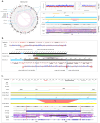Optical Genome Mapping as a Potential Routine Clinical Diagnostic Method
- PMID: 38540401
- PMCID: PMC10970541
- DOI: 10.3390/genes15030342
Optical Genome Mapping as a Potential Routine Clinical Diagnostic Method
Abstract
Chromosome analysis (CA) and chromosomal microarray analysis (CMA) have been successfully used to diagnose genetic disorders. However, many conditions remain undiagnosed due to limitations in resolution (CA) and detection of only unbalanced events (CMA). Optical genome mapping (OGM) has the potential to address these limitations by capturing both structural variants (SVs) resulting in copy number changes and balanced rearrangements with high resolution. In this study, we investigated OGM's concordance using 87 SVs previously identified by CA, CMA, or Southern blot. Overall, OGM was 98% concordant with only three discordant cases: (1) uncalled translocation with one breakpoint in a centromere; (2) uncalled duplication with breakpoints in the pseudoautosomal region 1; and (3) uncalled mosaic triplication originating from a marker chromosome. OGM provided diagnosis for three previously unsolved cases: (1) disruption of the SON gene due to a balanced reciprocal translocation; (2) disruption of the NBEA gene due to an inverted insertion; (3) disruption of the TSC2 gene due to a mosaic deletion. We show that OGM is a valid method for the detection of many types of SVs in a single assay and is highly concordant with legacy cytogenomic methods; however, it has limited SV detection capabilities in centromeric and pseudoautosomal regions.
Keywords: CA; CMA; OGM; SV; chromosomal microarray analysis; chromosomal rearrangements; chromosome analysis; copy number variant CNV; optical genome mapping; structural variant.
Conflict of interest statement
H.B. owns stock shares and options in Bionano.
Figures


References
-
- Waggoner D., Wain K.E., Dubuc A.M., Conlin L., Hickey S.E., Lamb A.N., Martin C.L., Morton C.C., Rasmussen K., Schuette J.L., et al. Yield of additional genetic testing after chromosomal microarray for diagnosis of neurodevelopmental disability and congenital anomalies: A clinical practice resource of the American College of Medical Genetics and Genomics (ACMG) Genet. Med. 2018;20:1105–1113. doi: 10.1038/s41436-018-0040-6. - DOI - PMC - PubMed
-
- Levy-Sakin M., Pastor S., Mostovoy Y., Li L., Leung A.K.Y., McCaffrey J., Young E., Lam E.T., Hastie A.R., Wong K.H.Y. Genome maps across 26 human populations reveal population-specific patterns of structural variation. Nat. Commun. 2019;10:1025. doi: 10.1038/s41467-019-08992-7. - DOI - PMC - PubMed
-
- Bocklandt S., Hastie A., Cao H. Bionano Genome Mapping: High-Throughput, Ultra-Long Molecule Genome Analysis System for Precision Genome Assembly and Haploid-Resolved Structural Variation Discovery. Adv. Exp. Med. Biol. 2019;1129:97–118. - PubMed
Publication types
MeSH terms
Substances
Grants and funding
LinkOut - more resources
Full Text Sources
Medical

